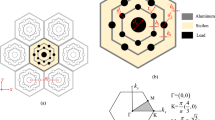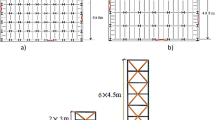Abstract
A framework for optimal design of lead rubber bearing (LRB) system is introduced based on the initial and life cycle cost of structures. The purpose of this framework is to minimize the initial and life cycle cost of building and simultaneously improve the seismic performance of the base isolated structure. Endurance time (ET) method is used to predict the seismic response of the building at continuous levels of hazard intensity. Before implementing the optimization process, a full factorial design is utilized, and the seismic performance of a total of 128 lead rubber base isolated structures with varying LRB design parameters is assessed using the ET analysis method. Accordingly, the parameters with the most significant impact on the responses are determined by the analysis of variance. These parameters are used as design variables in a multi-objective genetic algorithm to minimize the initial and life cycle cost of the building with LRB system. The cost analysis of the system requires evaluation of initial costs including the costs associated with the implementation of LRBs. To date, no appropriate cost model has been proposed for LRB systems in the literature; therefore, a simplified cost model for LRBs is developed. Also, a life cycle cost model is used to evaluate the structural performance in the form of economic measures based on the results obtained from the ET analysis. In order to illustrate the method, a prototype six-story building is studied here. According to the results, the proposed approach is found to be effective in reducing the initial and life cycle cost of the building with an acceptable amount of computational effort.






















Similar content being viewed by others
References
Abe M, Yoshida J, Fujino Y (2004) Multiaxial behaviors of laminated rubber bearings and their modeling. I: experimental study. J Struct Eng 130:1119–1132. https://doi.org/10.1061/(ASCE)0733-9445(2004)130:8(1119)
Ahmadipour M, Alam MS (2017) Sensitivity analysis on mechanical characteristics of lead-core steel-reinforced elastomeric bearings under cyclic loading. Eng Struct 140:39–50. https://doi.org/10.1016/j.engstruct.2017.02.014
ANSI/AISC 360 (2016) Specifications for structural steel buildings. American Institute of Steel Construction, Chicago, IL
ANSI/AISC 341 (2016) Seismic provisions for structural steel buildings. American Institute of Steel Construction, Chicago, IL
ASCE/SEI 7 (2016) Minimum design loads for buildings and other structures. American Society of Civil Engineers, New York, NY
Basim MC, Estekanchi HE (2015) Application of endurance time method in performance-based optimum design of structures. Struct Saf 56:52–67. https://doi.org/10.1016/j.strusafe.2015.05.005
Basim MC, Estekanchi HE, Vafai A (2016) A methodology for value based seismic design of structures by the endurance time method. Scientia Iranica 23:2514–2527. https://doi.org/10.24200/sci.2016.2310
Basim MC, Estekanchi HE, Mahsuli M (2018) Application of first-order reliability method in seismic loss assessment of structures with endurance time analysis. Earthq Struct 14:437–447
Charmpis DC, Phocas MC, Komodromos P (2015) Optimized retrofit of multi-storey buildings using seismic isolation at various elevations: assessment for several earthquake excitations. Bull Earthq Eng 13:2745–2768. https://doi.org/10.1007/s10518-015-9737-y
Constantinou MC, Kalpakidis IV, Filiatrault A, Lay RE (2011) LRFD-based analysis and design procedures for bridge bearings and seismic isolators. MCEER
Elenas A, Meskouris K (2001) Correlation study between seismic acceleration parameters and damage indices of structures. Eng Struct 23:698–704. https://doi.org/10.1016/S0141-0296(00)00074-2
Eröz M, DesRoches R (2008) Bridge seismic response as a function of the Friction Pendulum System (FPS) modeling assumptions. Eng Struct 30:3204–3212
Estekanchi HE, Basim MC (2011) Optimal damper placement in steel frames by the Endurance Time method. Struct Des Tall Spec Buildings 20:612–630. https://doi.org/10.1002/tal.689
Estekanchi HE, Vafai A, Sadeghazar M (2004) Endurance time method for seismic analysis and design of structures. Scientia Iranica 11:361–370
Estekanchi HE, Valamanesh V, Vafai A (2007) Application of endurance time method in linear seismic analysis. Eng Struct 29:2551–2562. https://doi.org/10.1016/j.engstruct.2007.01.009
Estekanchi HE, Vafai A, Basim MC (2016) Design and Assessment of Seismic Resilient Structures by the Endurance Time Method. Scientia Iranica 23:1648–1657. https://doi.org/10.24200/sci.2016.2236
FEMA 227 (1992) Federal Emergency Management Agency, Building Seismic Safety Council Washington, DC
FEMA P695 (2009) Quantification of building seismic performance factors prepared by the Applied Technology Council (Report No: ATC-63) for the Federal Emergency Management Agency, Washington, DC
Fragiadakis M, Lagaros ND (2011) An overview to structural seismic design optimisation frameworks. Comput Struct 89:1155–1165
Guo A, Shen Y, Bai J, Li H (2017) Application of the endurance time method to the seismic analysis and evaluation of highway bridges considering pounding effects. Eng Struct 131:220–230. https://doi.org/10.1016/j.engstruct.2016.11.009
Hariri-Ardebili MA, Sattar S, Estekanchi HE (2014) Performance-based seismic assessment of steel frames using endurance time analysis. Eng Struct 69:216–234. https://doi.org/10.1016/j.engstruct.2014.03.019
Ibarra LF, Medina RA, Krawinkler H (2005) Hysteretic models that incorporate strength and stiffness deterioration. Earthquake Eng Struct Dynam 34:1489–1511
Iemura H, Taghikhany T, Jain SK (2007) Optimum design of resilient sliding isolation system for seismic protection of equipments. Bull Earthq Eng 5:85–103. https://doi.org/10.1007/s10518-006-9010-5
Kalpakidis IV, Constantinou MC (2009a) Effects of heating on the behavior of lead-rubber bearings. I: theory. J Struct Eng 135:1440–1449. https://doi.org/10.1061/(ASCE)ST.1943-541X.0000072
Kalpakidis IV, Constantinou MC (2009b) Effects of heating on the behavior of lead-rubber bearings. II: verification of theory. J Struct Eng 135:1450–1461. https://doi.org/10.1061/(ASCE)ST.1943-541X.0000071
Kalpakidis IV, Constantinou MC, Whittaker AS (2010) Modeling strength degradation in lead -rubber bearings under earthquake shaking. Earthq Eng & Struct Dynam 39:1533–1549. https://doi.org/10.1002/eqe.1039
Kikuchi M, Nakamura T, Aiken ID (2010) Three-dimensional analysis for square seismic isolation bearings under large shear deformations and high axial loads. Earthquake Eng Struct Dynam 39:1513–1531
Kikuchi M, Aiken ID, Kasalanati A (2012) Simulation analysis for the ultimate behavior of full-scale lead-rubber seismic isolation bearings. In: 15th world conference on earthquake engineering, No. 1688
Kim J, Shin H (2017) Seismic loss assessment of a structure retrofitted with slit-friction hybrid dampers. Eng Struct 130:336–350. https://doi.org/10.1016/j.engstruct.2016.10.052
Kitayama S, Constantinou MC (2018) Collapse performance of seismically isolated buildings designed by the procedures of ASCE/SEI 7. Eng Struct 164:243–258. https://doi.org/10.1016/j.engstruct.2018.03.008
Krawinkler G (1999) Seismic demands for performance evaluation of steel moment resisting frame structures. John A Blume Earthquake Engineering Center Technical Report 132. Stanford Digital Repository
Lagaros ND, Fotis AD, Krikos SA (2006) Assessment of seismic design procedures based on the total cost. Earthquake Eng Struct Dynam 35:1381–1401. https://doi.org/10.1002/eqe.585
Lignos DG, Krawinkler H (2011) Deterioration modeling of steel components in support of collapse prediction of steel moment frames under earthquake loading. J Struct Eng 137:1291–1302. https://doi.org/10.1061/(ASCE)ST.1943-541X.0000376
Mashayekhi M, Estekanchi HE, Vafai A, Mirfarhadi SA (2018) Simulation of cumulative absolute velocity consistent endurance time excitations. J Earthquake Eng. https://doi.org/10.1080/13632469.2018.1540371
Matta E (2018) Lifecycle cost optimization of tuned mass dampers for the seismic improvement of inelastic structures. Earthquake Eng Struct Dynam 47:714–737. https://doi.org/10.1002/eqe.2987
Maurer S (2008) Seismic isolation systems with lead rubber bearings (LRB) product and technical information
Mazza F, Mazza M, Vulcano A (2017) Nonlinear response of RC framed buildings retrofitted by different base-isolation systems under horizontal and vertical components of near-fault earthquakes. Earthq Struct 12:135–144
Mazzoni S, McKenna F, Scott MH, Fenves GL, Jeremic B (2006) Open system for earthquake engineering simulation (OpenSees). Berkeley, California
Mitropoulou CC, Lagaros ND (2016) Life-cycle cost model and design optimization of base-isolated building structures. Front Built Environ 2:27. https://doi.org/10.3389/fbuil.2016.00027
Mitropoulou CC, Lagaros ND, Papadrakakis M (2010) Building design based on energy dissipation: a critical assessment. Bull Earthq Eng 8:1375–1396. https://doi.org/10.1007/s10518-010-9182-x
Mitropoulou CC, Lagaros ND, Papadrakakis M (2011) Life-cycle cost assessment of optimally designed reinforced concrete buildings under seismic actions. Reliab Eng Syst Saf 96:1311–1331. https://doi.org/10.1016/j.ress.2011.04.002
Montgomery DC, Runger GC (2010) Applied statistics and probability for engineers. Wiley, New York
Naeim F, Kelly JM (1999) Design of siesmic isolated structures—from theory to practicle. Wiley, New York
Ozdemir G (2015) Formulations of equivalent linearization of lead-rubber bearings for incorporating the effect of lead core heating. Earthq Spectra 31:317–337. https://doi.org/10.1193/041913eqs107m
Ozdemir G, Dicleli M (2012) Effect of lead core heating on the seismic performance of bridges isolated with LRB in near-fault zones. Earthq Eng & Struct Dynam 41:1989–2007. https://doi.org/10.1002/eqe.2170
Pourzeynali S, Zarif M (2008) Multi-objective optimization of seismically isolated high-rise building structures using genetic algorithms. J Sound Vib 311:1141–1160. https://doi.org/10.1016/j.jsv.2007.10.008
Riahi H, Estekanchi HE, Vafai A (2009) Endurance time method-application in nonlinear seismic analysis of single degree of freedom systems. J Appl Sci 9:1817–1832
Shin H, Singh MP (2017) Minimum life-cycle cost-based optimal design of yielding metallic devices for seismic loads. Eng Struct 144:174–184. https://doi.org/10.1016/j.engstruct.2017.04.054
Vitiello U, Asprone D, Di Ludovico M, Prota A (2017) Life-cycle cost optimization of the seismic retrofit of existing RC structures. Bull Earthq Eng 15:2245–2271. https://doi.org/10.1007/s10518-016-0046-x
Wen YK, Kang YJ (2001) Minimum building life-cycle cost design criteria. II: applications. J Struct Eng 127:338–346. https://doi.org/10.1061/(ASCE)0733-9445(2001)127:3(338)
Zhang J, Shu Z (2018) Optimal design of isolation devices for mid-rise steel moment frames using performance based methodology. Bull Earthq Eng 16:4315–4338. https://doi.org/10.1007/s10518-018-0321-0
Zou X-K, Wang Q, Li G, Chan C-M (2010) Integrated reliability-based seismic drift design optimization of base-isolated concrete buildings. J Struct Eng 136:1282–1295. https://doi.org/10.1061/(ASCE)ST.1943-541X.0000216
Acknowledgement
This work was supported in part by the Iran’s National Elites Foundation award 30/8030. Their support is gratefully acknowledged.
Author information
Authors and Affiliations
Corresponding author
Ethics declarations
Conflict of interest
The authors declare that they have no conflict of interest.
Additional information
Publisher's Note
Springer Nature remains neutral with regard to jurisdictional claims in published maps and institutional affiliations.
Rights and permissions
About this article
Cite this article
Mousazadeh, M., Pourreza, F., Basim, M.C. et al. An efficient approach for LCC-based optimum design of lead-rubber base isolation system via FFD and analysis of variance (ANOVA). Bull Earthquake Eng 18, 1805–1827 (2020). https://doi.org/10.1007/s10518-019-00754-6
Received:
Accepted:
Published:
Issue Date:
DOI: https://doi.org/10.1007/s10518-019-00754-6




